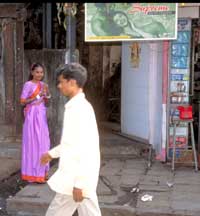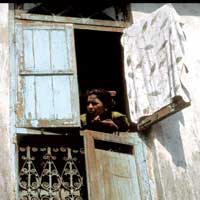 Basanti and Rabi were new faces in the hotel at Trisuli Bazar, Rasuwa. A few years ago they wouldn't have raised any eyebrows, but this time there was a group of people attending a safe migration awareness course. They asked themselves why an innocent-looking 19-year-old girl was staying with a much older man. A few of the guests casually questioned the pair. Basanti said she was going to marry Rabi who had courted her for two years. But from Rabi they received several different answers saying Basanti and he were visiting relatives, shopping and looking for work.
Basanti and Rabi were new faces in the hotel at Trisuli Bazar, Rasuwa. A few years ago they wouldn't have raised any eyebrows, but this time there was a group of people attending a safe migration awareness course. They asked themselves why an innocent-looking 19-year-old girl was staying with a much older man. A few of the guests casually questioned the pair. Basanti said she was going to marry Rabi who had courted her for two years. But from Rabi they received several different answers saying Basanti and he were visiting relatives, shopping and looking for work.
Sensing something amiss, the police were called. By the time they arrived, Rabi had disappeared and Basanti was starting to come to terms that she had almost certainly escaped being trafficked, possibly for sex work.
Once Basanti may have ended up as another statistic in Mumbai's Kamathipura. Thanks to the vigilance of locals, many of whom had participated in awareness and sensitivity programs with various anti-trafficking groups, Basanti returned home safely to her village.
There has been an impressive increase in the number and sophistication of such programs since the problem of girl trafficking started being openly talked about in 1992, following the rescue and repatriation of 200 women from Mumbai. Local charities have successfully publicised the problem of trafficking for sex work, both nationally and abroad. Over the past decade many hundreds of girls have been rescued from potential traffickers and many more repatriated and retrained by such agencies.
But from all indications, the problem of trafficking is not decreasing. It is difficult to estimate without reliable figures, but numbers range between 5,000 and 20,000 Nepali women trafficked every year. On average, 100 legal cases are brought against traffickers with a 25 percent level of conviction. Gobinda Thapa, the Assistant Inspector General of Police, researched his doctoral thesis on girl trafficking, and was responsible for setting up the first Women's Cell in 1996, allowing women a specialist environment in which to report crimes.  He explains policing trafficking metaphorically: "Migration is a stream running down and traffickers are fishing in that stream. The traffickers are waiting for the easy prey, fishing out of the stream." He adds, "It is a general principle in the world of crime and criminals that the criminals are always one step ahead of the police."
He explains policing trafficking metaphorically: "Migration is a stream running down and traffickers are fishing in that stream. The traffickers are waiting for the easy prey, fishing out of the stream." He adds, "It is a general principle in the world of crime and criminals that the criminals are always one step ahead of the police."
Armina of the group Maiti Nepal agrees that the problem is widening, possibly even in response to the success of awareness programs in some areas. "There are so many ways to go and they are very cunning people. There are places we have not been to yet."
Criminal networks have widened: women and girls are not only being trafficked from villages but from the capital. They are taken to Mumbai, the Gulf states and South-east Asia, besides servicing the domestic market.
Two separate issues are often confused when it comes to trafficking. It does not refer only to exploitation through sex work, but any form of labour exploitation, and occurs indigenously as well as across national borders. The flow of migration, exacerbated by the Maoist conflict, means that it is very hard for potential rescuers to spot women who are being trafficked for exploitation as opposed to migrating of their own free will.
Thapa explains, "It is very complicated and difficult to demarcate. I am pretty sure that all the women who are intercepted are not being taken for prostitution or exploitation. You can't stop every girl, as that will also violate their human rights."
The issue of rights and interception is one that has created a divide in the NGO community. Many claim that a majority of women who are prevented from crossing the border into India are not being trafficked for exploitation, and that their interception is therefore an illegal violation of their right to migrate. Renu Raj Bhandari, a former Human Rights Rapporteur, is concerned that interception programs may also have a negative impact on how women view migration. "I am really concerned that the right to mobility for women, which took years to establish, is now being taken away in the name of welfare. Women are being forced to migrate clandestinely," she says.
This theory is borne out by the case of Shweta, 14, who spent four days in a Maiti Nepal transit home after attempting to travel from Birganj to India in order to visit her sister. Upon return, she told her friends, "If you go with a boy to India, they will catch you and take you to the transit home." When such an impression is widely held, it could act as a disincentive for other women to leave their villages at all.  Another misconception amongst many women is that trafficking is associated purely with prostitution. One woman who was intercepted and then repatriated told Save the Children researchers: "People in my village believe that if a girl goes to India, she will be sold in the red light area." No large-scale surveys have been carried out on the subject, but anecdotal evidence suggests that in many areas there is currently an overarching association of all migration with trafficking and of trafficking with prostitution. This means that migration and interception may themselves carry the same social stigma as prostitution.
Another misconception amongst many women is that trafficking is associated purely with prostitution. One woman who was intercepted and then repatriated told Save the Children researchers: "People in my village believe that if a girl goes to India, she will be sold in the red light area." No large-scale surveys have been carried out on the subject, but anecdotal evidence suggests that in many areas there is currently an overarching association of all migration with trafficking and of trafficking with prostitution. This means that migration and interception may themselves carry the same social stigma as prostitution.
This is a problem that voluntary organisations are aware of and attempting to face. The focus in most awareness programs is now on 'safe migration', emphasising that women should have precise details as to where they will be working and should always discuss their plans before leaving.
There is a slow trend towards a reduction in interception programs at the Indian border and a focussing of resources on prevention and rehabilitation measures instead.
Even within Maiti Nepal, previously the biggest exponent of the interception method, there has been a subtle shift in attitude. Says Armina: "When we intervene, the traffickers are not always with them. So it is very difficult to tell.Our awareness programs focus on safe migration." She denies the suggestion, however, that Maiti is scaling back its border operation as a result.
There has been a gradual shift towards a more 'rights-based' approach to the problem of girl trafficking. With 'safe migration' the current philosophy, border interception and surveillance programs are being cut back by many organisations.
There remain many conflicts, however, over issues such as the level of voluntary sex work and whether this should be discouraged. As the root causes of trafficking are investigated, issues become complicated and blurred, as there is very little that is not related to the wider social discrimination faced by Nepali women.


